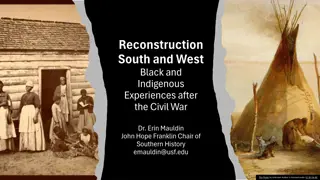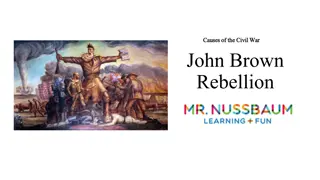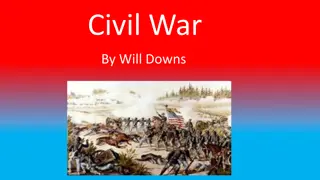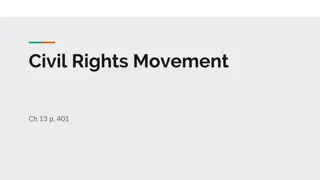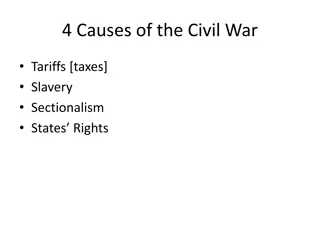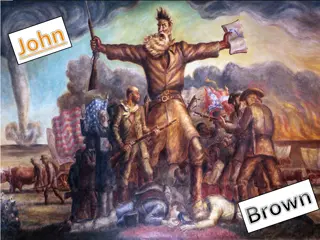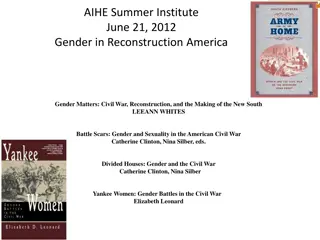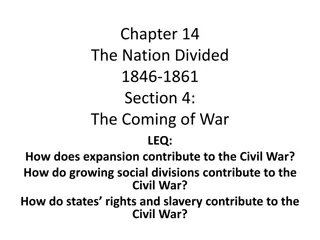Impact of the Civil War on Georgia: Roles and Key Events
Georgia played a significant role in the Civil War, facing the Union blockade, experiencing the effects of the Emancipation Proclamation, engaging in battles like Chickamauga, being part of Sherman's Atlanta Campaign and March to the Sea, and hosting the infamous Andersonville prison. The state's involvement and experiences during this tumultuous period were profound and left lasting impacts.
Download Presentation

Please find below an Image/Link to download the presentation.
The content on the website is provided AS IS for your information and personal use only. It may not be sold, licensed, or shared on other websites without obtaining consent from the author. Download presentation by click this link. If you encounter any issues during the download, it is possible that the publisher has removed the file from their server.
E N D
Presentation Transcript
Civil War in Georgia SS8H5 Analyze the impact of the Civil War on Georgia. b. Explain Georgia s role in the Civil War; include the Union blockade of Georgia s coast, the Emancipation Proclamation, Chickamauga, Sherman s Atlanta Campaign, Sherman s March to the Sea, and Andersonville.
Confederacy After Abraham Lincoln was elected president in 1860, seven Southern states seceded from the Union. Lincoln was firmly against the spread of slavery, and Southerners were worried that he would eventually destroy their livelihood. The Southern states formed the Confederate States of America and elected Jefferson Davis as president of the Confederacy.
Lincoln Abraham Lincoln was inaugurated as the U.S. 16th president on March 4, 1861. Lincoln s goal was to preserve the Union and he asked the Southern states to consider rejoining. He addressed the slavery issue by stating that he would not interfere with the institution of slavery in the states where it exists. It was not enough, though, and the Civil War officially began when Confederate troops opened fire on Fort Sumter on April 12, 1861.
Fort Sumter Fort Sumter was a Union fort that protected the harbor of Charleston, South Carolina. The Union forces inside Fort Sumter were already low on ammunition and food, so they surrendered the next day. Nobody was killed during the actual battle; however, one person was killed in a 50-gun salute to the flag.
Blockade In response, Union leaders quickly set up a blockade of Southern ports in order to cutoff Confederate commerce and weaken the South. Union ships lined the southern coast and would not let any Confederate ships in or out. Occasionally, blockade runners snuck through and were able to make it to Europe to trade for supplies.
In April 1862, Union soldiers landed on Tybee Island and captured Fort Pulaski, the fort protecting Savannah. Once the brick fort was obliterated, the North was able to blockade the important port of Savannah. Hardly any Confederate ships could make it in or out of Georgia.
Emancipation Five days after the Union victory in the Battle of Antietam, President Lincoln issued the Emancipation Proclamation. This freed all slaves in states fighting against the Union. Lincoln s proclamation shifted the focus of the Civil War from preserving the Union to freeing the slaves.
Emancipation For Southerners, the Emancipation Proclamation was final proof that the North would destroy the southern way of life. Northern abolitionists saw the emancipation of slaves as a great victory, and now had a valuable reason to fight. With the proclamation, President Lincoln made it clear that the Union s purpose was now to free the slaves.
Emancipation The Emancipation Proclamation also invited former slaves to join the Union army. Many African Americans enlisted and fought bravely, aware that they were fighting for the freedom of their people. As the Union Army freed slaves, an estimated 3,500 black Georgians joined the Union against the Confederates.
Georgia Georgia was free from major battles during the first two years of the Civil War. The Union soon realized that destroying Atlanta would mean defeat for the Confederacy. In 1863, Georgia became a target for the Union.
Chickamauga After capturing Chattanooga, a railroad center in Tennessee, 58,000 Union troops marched south into Georgia on September 18, 1863. 66,000 Confederates fought against the Union soldiers along Chickamauga Creek for two days.
Chickamauga After 16,000 men were killed from both sides, the Union army retreated back to Tennessee. The Battle of Chickamauga was a very important Confederate victory and it became the largest Union defeat.
Atlanta Campaign In 1864, General William Tecumseh Sherman moved his Union Army south from Tennessee to Atlanta. They fought Confederate soldiers along the way, leaving a path of destruction and chaos.
Atlanta Campaign On September 2, 1864, Sherman s troops captured Atlanta and set the city on fire. Sherman s Atlanta Campaign marked the beginning of the end of the Civil War.
March to Sea The next day, Sherman split his army in two and continued his March to the Sea from Atlanta to Savannah. Sherman instructed his soldiers to destroy any towns and plantations along the way in order to crush the remaining fighting spirit in the South.
March to the Sea Half of Sherman s army marched through Decatur, Covington, Eatonton, and Milledgeville, while the other half traveled through Jonesboro and Gordon. The two groups met in Sandersville and headed on to Savannah.
March to the Sea Sherman s march cut Confederate supply lines and crushed the spirit of the Confederate army. Union troops captured Savannah on December 21, 1864, and Sherman presented the city of Savannah to Abraham Lincoln as a Christmas gift. The Confederacy surrendered in April 1865.
Andersonville One of the most notorious sites of the Civil War was the Confederate prison camp in Andersonville, Georgia. More than 45,000 captured Union soldiers were sent to the overcrowded camp.
Conditions Inside the prison, there was barely any food to eat and the only water source was a filthy stream that flowed through the camp. Prisoners lived outside with few clothes and had to construct their own shelters made from sticks, cloth scraps, and mud. Living conditions were terrible and many suffered from starvation, disease, and insect attacks.
Prison Camp The prison was overcrowded and unsanitary, and over 13,000 of the captives died of disease and starvation. Prisoners lacked life s basic necessities inside Andersonville s walls. The camp had the highest death rate of any Civil War prison. After the war, the Union executed the prison s commander, Major Henry Wirz.











